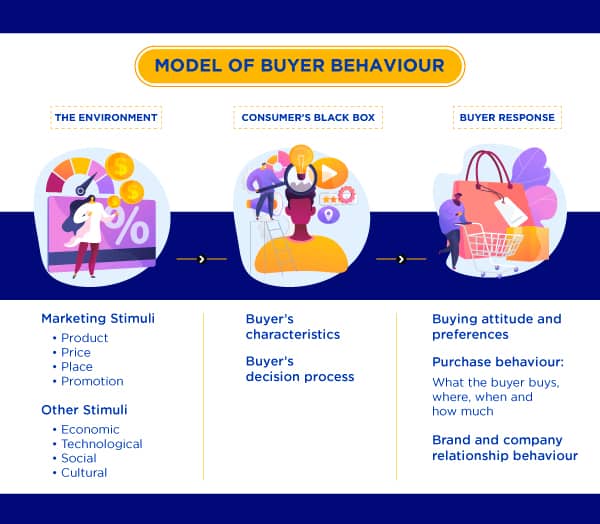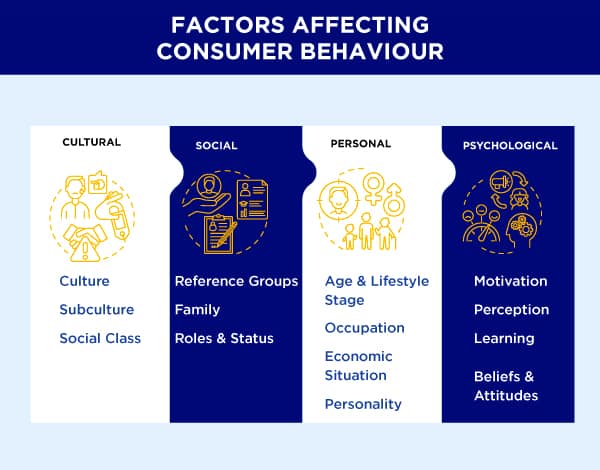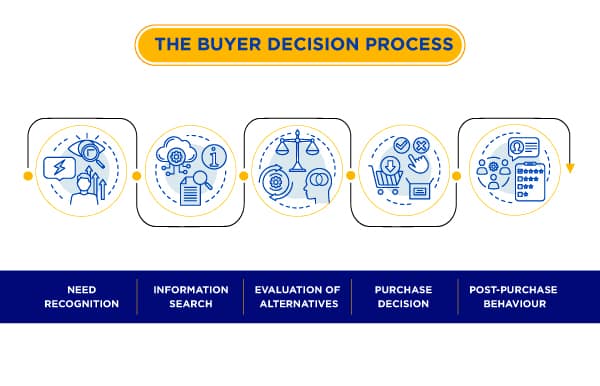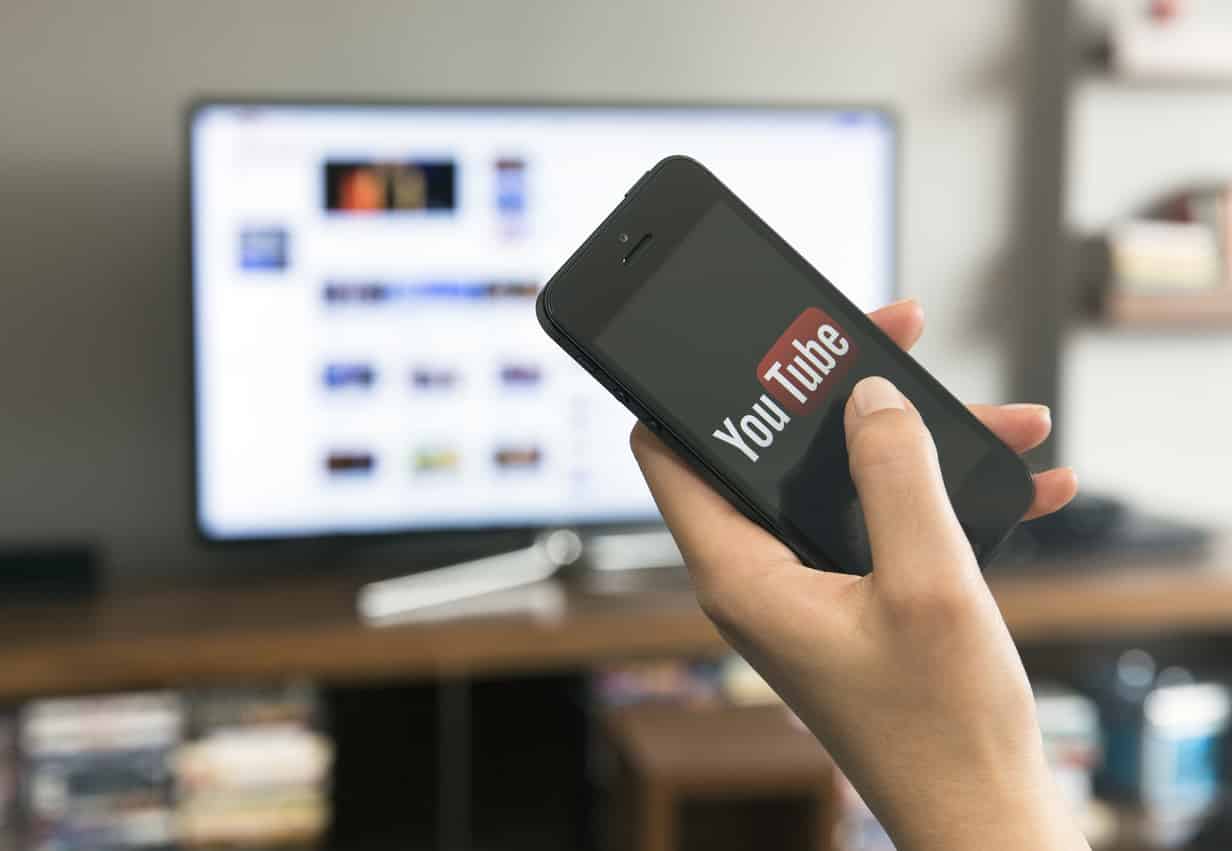Have you ever wondered why sometimes you choose an Apple over a Doughnut?
Oh, maybe because you always look for healthy alternatives.
Or sometimes a Doughnut over an Apple?
No, not because you don’t want to lead a healthy lifestyle but because as a consumer your behaviour changes.
There’s a lot that can be learnt on Consumer Behaviour and if you are interested then check out the Digital Marketing Courses offered by Great Learning. These courses would enable you to design and evaluate marketing strategies based on the fundamentals of consumer buying behaviour.
We as consumers make purchase decisions every day. Buying decisions are treated as the focal point for marketing. Large companies research a lot about consumer buying decisions to comprehend what they buy, from where they buy, why they buy, how and how much they buy, and when they buy. Marketers attempt to study the actual consumer purchases behaviours through deep research. Understanding the minds of consumers is not as easy as it sounds, as the answers are locked deep inside the minds of the consumers.
| Who is a Consumer? A consumer is an individual who buys products or services for personal use. They don’t buy things for commercial use. Brands use consumer marketing/advertisements to sell their products to the end consumers, who ultimately consume their products. Such advertising campaigns aim to acquire potential consumers and retain existing consumers. |
In this article, we will understand the meaning, model, importance, and factors of Consumer Behaviour. We will deep dive into the types, processes, patterns, and segmentation criteria of consumer behaviour. We will also analyze the effect of the pandemic on consumer behaviour.
So, let’s deep dive in!
- Meaning of Consumer Behaviour
- Factors Affecting Consumer Behaviour
- Types of Consumer Behaviour
- The Consumer Decision Process
- Consumer Behaviour Patterns
- Consumer Behaviour Segmentation
- Importance of Consumer Behaviour
- Examples of Consumer Behaviour
- Impact of Pandemic in Consumer Behaviour
- Conclusion
MEANING OF CONSUMER BEHAVIOUR
The American Marketing Association has defined consumer behaviour as, “The dynamic interaction of affect and cognition, behaviour, and the environment by which human beings conduct the exchange aspects of their lives.”
Consumer behaviour has two aspects; firstly, the decision process involving complex variables, and secondly, the final purchase activity of the consumers. The marketers base their research around the central question, which is “how a consumer response to the marketing efforts is carried out by any company?” The marketers use the following model of buyer behaviour.

The above model showcases that marketing and other external stimuli enter a consumer’s “black box” and produce certain responses resulting in a purchase or building a buyer’s attitude. The marketing stimulus consists of four Ps —product, price, place, promotion. Other stimulus includes the external environmental variables namely, economic, technological, social, and cultural events or forces. All these inputs enter the buyer’s black box, where it is processed and turned into a few observable responses such as the buyer’s attitudes, purchase behaviour, or brand relationships.
The major interest area for any marketer is to recognize how the stimulus is converted into responses inside the brain of the consumer or the black box. The marketers need to understand whether there are certain buyers’ characteristics that influence how they perceive and react to stimuli. Secondly, during the process of decision-making, the behaviour of buyers gets affected. Let’s have a look at the factors that affect consumer behaviour and the decision process.
FACTORS AFFECTING CONSUMER BEHAVIOUR
There are many levels of factors that influence the buying behaviour of consumers. The buying decisions are strongly influenced by variables such as cultural, social, personal, and psychological factors. Given below is the diagrammatic representation.

- Cultural Factors
Culture plays an important role in the decision-making of consumers. Culture refers to the values, beliefs, traditions, and perceptions that guide an individual in decision-making. Culture can also be understood as the acceptable human behaviour that is conveyed from one generation to another. It is imperative to understand here that culture influences an individual’s attitude and behaviour such as their eating and food habits, dresses and appearances, communication and language, relationship with family and organizations, learning and working habits.
Each culture contains smaller subcultures. Subculture comprises a group of people with a shared value system. Subcultures may consist of nationalities, religions, geographical regions, and even racial groups. Marketers consider these subcultures as an important market segment and opt for making tailor-made products to satisfy their needs.
Every society has some structure of social class. Social class is determined by multiple factors such as income, occupation, education, wealth, and other variables. Marketers have developed a socioeconomic classification for urban households based on the education and occupation of the chief wage earner of the household. For rural households, classification is based on education and the nature of dwelling. The social class attracts the interest of the marketers as these segments have distinct brand preferences for clothing, consumer durables, leisure activities, etc.
- Social Factors
Consumer behaviour is largely influenced by social factors, such as family, reference groups, and social roles and status. Reference groups expose individuals to new behaviours and lifestyles and shape their attitudes and self-concept. This formation of attitude and self-concept is triggered by direct or indirect points of comparison or reference. The task of marketers, in this case, is to identify the reference groups for their target markets. The importance of reference groups varies across products and services.
Family members strongly influence the decisions about the purchase activity of any individual. Marketers possess a deep interest in understanding the role and influence of wives and children in purchase decisions for different products and services. The involvement of husband and wife varies from one product to another. Traditionally, wives (women) are more involved in purchase decisions for food, household products, and clothing for the family. With the changing scenario and a greater number of working women in the family, the wives are also involved in making key decisions such as the purchase of a car, home, or vacation. According to research, US women make 85% of the family purchase, which accounts for spending almost two-thirds of a nation’s GDP. In today’s social scenario, where families are becoming more nuclear, children do have a strong influence on the family’s buying decisions. Marketers are coming up with products that are exclusively made for children —toys, clothes, stationery, health drinks, or personal care range.
An individual belongs to many groups which consist of family, clubs, and organizations. Every individual’s position in each group is defined both in terms of roles and status. A role comprises all activities an individual is expected to perform as per the people around him/her. Each role carries some status along with it. These statuses reflect the general esteem given to it by society. For instance, Estella is a brand manager for Vodafone; in her family, she plays the role of a wife and mother; in the social club for her housing society, she is the president. As a brand manager, Estella will buy the kind of clothing which suits and reflects her role and status of being a brand manager.
- Personal Factors
The buying behaviour of an individual is also influenced by their characteristics such as age and lifecycle stage, occupation, economic situation, lifestyle, and personality. The preferences of the consumers change with their age. Preferences and choices in food, furniture, clothes, and recreation are usually age-related. Buying tastes and preferences also change over the years based on the Lifecycle Stage.
Marketers have identified five life-cycle stages.
- The Youth Segment: Consumers under the age of 18
- Getting Started: Consumers in the age group of 18 to 35, these consumers are going through first in life experiences such as graduating college, getting their first car, first loan, marriage, or first child.
- Builders: Consumers in the age group of 35 to 50, these consumers are in their peak earning years.
- Accumulators: Consumers in the age group of 50 to 60, these consumers worry about their retirements and invest wisely.
- Preservers: Consumers over the age of 60, these consumers intend to maximize their retirement income to maintain the desired lifestyle.
The occupation of a Consumer affects the choice of goods and services bought. White-collar workers prefer business suits whereas blue-collared prefer rugged clothes. Marketers identify the occupational groups and attempt to serve them in the best possible manner. The economic situation of consumers also influences product choice. Consumers are price-sensitive; therefore, marketers redesign, reposition and re-price their products in times of recession.
Consumers may have a common subculture, social class, or occupation, but they may differ in their lifestyles. Lifestyle involves measuring dimensions for the consumers which include activities (hobbies, sports, and shopping), interest (fashion, food, and recreation), and opinions (social issues and business). The understanding of lifestyle helps marketers in gaining insights about changing consumer values.
Consumers possess a distinct personality that influences their buying behaviour. The unique psychological characteristics that lead to consistent and lasting responses are termed personality. Traits such as associability, self-confidence, autonomy, adaptability describe personality. Marketers tend to associate their brands with a unique set of traits to match the personality of the target audience. For example, Johnson and Johnson with compassion, kindness, and care, Dove with purity and sincerity, etc.
- Psychological Factors
The buying choices of consumers are further influenced by psychological factors such as motivation, perception, learning, beliefs, and attitudes.
Individuals have many needs at any given point in time. These needs can be physical or psychological. The need for recognition, esteem, and belongingness are examples of psychological needs. Needs become motive when they are aroused with a sufficient level of intensity. Companies employ a team of psychologists, social scientists, and anthropologists to carry out motivation research for their brands. Perception is the process by which consumers select, organize and interpret data to form a meaningful picture of the world. As individuals can form different perceptions from the same stimulus, marketers should be very careful while designing their promotion and communication campaigns.
Learning is the change in human behaviour which arises from experience. Marketers believe that if a purchase experience is rewarding, the consumer will be delighted and the action will be reinforced. If the purchase experience is unsatisfactory, the consumer shall be frustrated and might not repurchase the brand. Through learning, individuals acquire beliefs and attitudes. Belief is a descriptive thought an individual possesses about anything. It can be based on real knowledge, faith, or opinion. Attitudes are consistent feelings and tendencies about any object or idea. Marketers always attempt to fit their products and services in the existing beliefs and attitudes of the consumers to achieve maximum returns.
TYPES OF CONSUMER BEHAVIOUR
There are four types of Consumer Behaviour
- Complex Buying Behaviour
This behaviour is observed when consumers intend to purchase an expensive, infrequently bought product like a house or a car, they are highly involved in the entire purchase process and research a lot before the actual investment.
Marketers who are selling high-involvement products should be aware of the information gathering and evaluating alternative behaviour of the consumers. They can build their strategies in building important attributes in their products that typically consumers seek. The marketers should also attempt to assist the consumers with the queries they have.
- Dissonance-reducing buying Behaviour
This behaviour is often observed when consumers are involved in a luxurious, uncommon, and risky purchase, but observes little or no difference between the brands. For instance, a consumer who is looking for a smart television may be highly involved in the buying process as the product is expensive. Also, since a lot of brands give similar features and product attributes, consumers might consider brands that have offerings in the same range. Since there is not much difference between the perceived brand the consumers might choose to purchase the brand that offers better prices or discounts or purchase convenience.
- Habitual Buying Behaviour
Habitual Purchases are generally the ones where there is less or no involvement with the brand or category. The consumer has no brand loyalty. Consumers don’t require much information about product features. As consumers, we do not put a lot of thought into buying items like a matchbox, lighter, etc. For these brands Television ads, print commercials like magazines and newspapers attempt to build a positive attitude among consumers.
- Variety – Seeking Behaviour
In this kind of behaviour, the consumer buys a product, not because they were not satisfied with the earlier product but because the consumers seek variety. For instance, you might choose a snack item/brand, without much assessment and then evaluate the product during consumption. The next time you might pick another brand to explore new tastes. Brand Switching, in this case, occurs for the sake of variability rather than dissatisfaction or dissonance. Market leaders and market challengers intend to pursue such buyers through their different sets of strategies. A Market Leader would run reminder advertisements and encourage habitual buying while a market challenger brand would encourage variety-seeking attributes through sales promotional techniques like discounts, deals, free samples, etc.
THE CONSUMER DECISION PROCESS
Buying your favourite stuff makes you happy! Isn’t…
Have you ever wondered about the process behind it? Yes, every decision you make is a process of activities. Let’s understand it.

- Need Recognition: The buying decision process begins with the identification of need where the consumer recognizes the need or requirement. The need can be triggered by internal or external stimuli. For instance, an advertisement or discussion with friends may arouse the need for a smartphone or a tablet. Marketers at this stage should research the consumer needs and the appropriate products that can satisfy those needs.
The above figure suggests that a consumer passes through all five stages in every purchase decision. Let us discuss these in detail.
- Information Search: In this stage, consumers attempt to seek information about the products/ services that will satisfy their needs. A consumer who is interested in purchasing a home might start meeting property agents visit appropriate websites or gather information through newspapers. Buyers can obtain information from various sources. These include personal sources (family, friends, and neighbours), commercial sources (advertising, display, and websites), public sources (mass media, internet searches, and consumer ratings), and experiential sources (handling, using, and examining the product).
- Evaluation of Alternatives: By now the consumers were only gathering information. In this stage, consumers use that information to assess alternative brands in the choice set. Consumers arrive at a judgment to buy a product or service through some evaluation procedure. This evaluation procedure varies from one buyer to another. Suppose a consumer wishes to purchase a wedding gown, she might evaluate the alternatives based on four attributes — style, economy, price, and warranty. Marketers should study the consumers and identify how exactly they evaluate any brand for final purchase. If marketers can recognize the evaluation procedure they can very well influence the choices of the consumers.
- Purchase Decision: In the evaluation stage, the buyer ranks the brand and forms an intention to purchase. In this stage, the consumer finally purchases the most preferred brand. Here, two factors come in between the purchase intention and purchase decision —the attitude of others being the first and the unexpected situational factors being the second. If a close friend or family member of the consumer thinks to invest in an electric car, then chances of purchasing a petrol/diesel car are reduced. Similarly, unexpected factors such as changes in the economy, price drop by a close competitive brand, and word-of-mouth may also change the purchase intention and decision of the consumers.
- Post-purchase Behaviour: The job of the marketer does not end after the product is purchased by the consumer. In this stage, marketers take further action after the purchase based on their satisfaction or dissatisfaction achieved after using the product or service. Marketers know that consumer satisfaction is a key to building profitable relationships with consumers. Satisfied consumers spread positive word-of-mouth and therefore, every marketer attempts to delight consumers by exceeding their expectations.
By studying the buyer’s decision process, marketers try to find ways to help consumers move through all the stages. Sometimes, these stages might change if a consumer goes for a routine purchase. For instance, consumers buying their regular brand of soap might just feel the need and go right to the purchase decision, skipping the other stages of the decision process. However, the above model is treated as ideal as it considers all situations that arise from a simple or complex purchase.
CONSUMER BEHAVIOUR PATTERNS
Every consumer has a unique buying pattern, whether they realize it or not. A fitness freak who jogs every morning grabs some coconut juice while returning. To the individual, it’s just a part of the routine, to the coconut outlet it’s an established buying pattern. If this individual moves to any other locality/city, he is likely to establish a new routine with a new outlet or maybe a commodity but the buying pattern shall remain the same.
Buying pattern typically refers to the “why” and “how” a consumer takes a purchase decision. These are routines or habitual buying that a consumer establishes.
These patterns can be grouped based on:
- Place of Purchase – Consumers usually divide their purchase choice between various stores even if all the stores offer all items. For instance, you might choose to buy home furnishings from HomeTown even if the same is available in your local hypermarket. When a consumer has the competence and access to purchase the same kind of products in different stores, they may not be loyal to any store. Analysing consumer behaviour in terms of preferring an outlet over the others might help marketers to identify key store locations.
- Item Purchased – Understanding the shopping cart of the consumers provides critical insights to the marketers. Consumers prefer to buy essential items in bulk while luxury items are less frequently bought in smaller quantities. The purchase of these items is also influenced by the perishability of the product, price, purchasing power of the consumer etc. All these valuable insights are key in understanding the consumer pattern and devising marketing strategies.
- Time and Frequency of Purchase – Consumers prefer to shop at their convenient time, and now with E-Commerce in place, they might shop at the oddest hours too. Brands that identify such purchase patterns stay at a competitive edge and attempt to match their products based on demand.
- Method of Purchase – A Consumer might buy through an online portal or walk into the store. Whichever way the purchase is made giving attractive offers or suggesting new items at the payment pave way/point of purchase is crucial. The purchase method, either cash, card or UPI also allows the Brands to get some brownie points from the consumer. Free shipping or a cashback always delights the consumer.
The way a consumer purchases a product speaks a lot about their pattern. Gathering such information and building insights may help marketers to identify new techniques to make consumers delighted and pursue them to buy often with higher values.
CONSUMER BEHAVIOUR SEGMENTATION
Segmenting and targeting appropriate consumers have always been critical market strategies. With increased personalization and consumer experience, effective market segmentation has become crucial for business growth and success. When marketers divide their consumers based on their knowledge, attitudes, uses, and response to a product, it is known as behavioural segmentation. Marketers believe that identifying behaviour variables is the starting point for structuring market segments.
The techniques used to segment the markets based on behavioural variables are:
- Occasion: Market segmentation can be done according to the occasion when the consumers use a product or service. This technique provides a rich insight to expand market possibilities. There can be 3 types of occasions that a marketer can target.
- Universal Occasion – An Occasion that applies to the majority of target audiences. An example of this can be the promotional campaigns by Coca-Cola on different occasions like Diwali or Christmas. Celebrations also use the same technique to promote their products on Rakhi or Diwali.
- Recurring -Personal Occasions – An occasion for an individual consumer that results in a purchase consistently. For instance, Brands offer discount coupons, offers exclusively on their consumer’s birthdays or anniversaries.
- Rare-Personal Occasion – These occasions are also individual consumer-driven but are more irregular and spontaneous. For instance, offers can be given to bridesmaids on the purchase of a dress of the bride.
- Benefits Sought: Consumers are grouped based on the benefits they seek from a product or service. When consumers select any brand, it depicts the motivating factor that influenced their decision. For instance, a consumer may seek either of four benefits from a toothpaste brand – price, medicinal importance, taste, or functional use. This technique provides the marketer with an opportunity to define and position the attributes of the brand. It also emphasizes its superiority over its competitors.
- User Status: Using this technique, the consumers are divided into groups depending on whether they are patronizing a product or service, or not. Marketers are segmented based on regular users, first-time users, ex-users, potential users, and non-users. For example, in the hospitality sector, airlines and hotels try to provide the best service to retain their consumers.
- Usage Rate: Depending on the rate of usage of a product or service, consumers can be divided into three categories —light users, medium users, and heavy users. For
For example, regular consumers get bonus points on their loyalty cards. The Usage behaviour holds a strong indicative value of loyalty, churn, or lifetime value. - Attitude: Consumers are segmented based on their attitude towards the product or service — enthusiastic consumers, positive consumers, indifferent consumers, and hostile consumers.
- Loyalty Status: A market is also segmented based on the loyalty of consumers. Loyal consumers are the most valuable assets for any business. They have high lifetime value and are very economical to retain. These consumers later turn into brand advocates. If brands analyze the behavioural data of such consumers, they can easily understand their needs and level of loyalty and hence can surely satisfy and retain them. For instance, Uber’s loyalty program enables consumers to earn points that can be redeemed from miles to meals.
IMPORTANCE OF CONSUMER BEHAVIOUR
Understanding the behaviour of consumers helps marketers
- To identify new products that are required by the consumers
- To identify those moments, or touch points when consumers are open to influence.
- To identify how to advertise their products in a way that creates an impact on consumers.
- To reach and engage consumers and convert them for purchase
EXAMPLES OF CONSUMER BEHAVIOUR
Imagine you are planning to shift into a new locality/home. Here’s how your behaviour to decide with the same intention shall vary based on your life stage.
- Getting Started: You would probably choose your locality near your college or office so that commuting becomes easy. You would also prefer to have all superstores or malls within a diameter of 5kms to have a fun outing or late-night movies.
- Builders or Accumulators: You would probably choose to stay in a secured gated society that gives you all amenities so that your family stays safe while you are at work or on business travel. You would also prefer to have easy accessibility to your children’s school/college.
- Preservers: You may prefer to stay close to nature, housing societies that offer security along with greenery and less hustle bustle
Similarly, if you plan to take a break and visit the nearby hill station, your decision making might vary based on the people you will be accompanying. If it’s a trip with friends you may probably choose to have an adventure setup like trekking, river rafting, staying in camps etc. while you might not choose the same option if you are travelling with elderly parents or kids.
IMPACT OF PANDEMIC IN CONSUMER BEHAVIOUR
Pandemic had an impact on our jobs, our lives, from being more aware of our physical and mental health to managing work and home together, attending zoom calls to live yoga classes …. Everything has changed. Pandemic has made marketers think about more innovative products and approaches to acquire and retain consumers. Let’s have a look at the emerging consumer behaviour trends.
- The WFH Model
Pandemic has converted our homes into offices, classrooms, gyms, movie theatres, etc. Our smartphone has apps that allow us to shop for essentials in just a few clicks. Our homes have become the hotspots where all activities are going on, and that for sure isn’t going away any time soon. The demand for products like office equipment, printers, treadmills, and services like internet services, in-home personal services have grown exponentially when consumers worked from home. The experts believe that consumers will definitely enjoy normalcy but they would still do and explore such activities from their homes.
- Preference for Shopping
As consumers are still within the pandemic safety measures, they prefer online shopping in view to keep themselves and their families safe. But that doesn’t mean that the consumers won’t prefer the brick-and-mortar store. The future of shopping might not be so simple, marketers should be thinking of a hybrid model for both online and offline stores.
- Convenience and Hygiene
Brands have to be creative in their approach as they shouldn’t be compromising on the government rules of social distancing or sanitizing the outlets. As the pandemic measures would ease out and brands would plan to resume their normal functioning, they should think about offering both conveniences along with safety. For instance, restaurants may offer digital hubs to choose the food, cashless payments, contactless delivery, etc.
- More Options, Less Loyalty?
Brands have always opinionated that Brand Loyalty would drive in more sales and revenue. Before the pandemic consumers would love to shop from retail outlets and would prefer an online store typically when the goods are not available locally or a customizable product is required. In the pandemic condition (when all stores were closed), consumers explored the options of online shopping where from a candy to a precious stone can be ordered. The increased convenience and faster shipping resulted in Brand switching. A consumer who gets a better offer would choose that offer regardless of previous purchase history. Brand Loyalty is still an effective strategy but the brands have to understand the consumer pattern and then build on the same.
- Value and Experience – The Guru Mantras
Today’s consumers are more empowered and hence they have an elevated expectation both in terms of value and experience. Consumers seek quality products along with a purpose-driven brand. Consumers look closely at the way brands are addressing social and environmental issues. Brands can create high value and brand-consistent online content to engage consumers and build a brand personality. They may also offer consumers to “experience” their brand in their physical stores before any purchase.
| Quick Fact In 2020, According to a McKinsey’s Consumer Sentiment Study, more consumers are expected to make portions of their purchase online even post-COVID. |
Conclusion
We have observed that each consumer possesses a unique behaviour. We also deciphered that these behaviours can be influenced. You as a marketer may study these patterns and behaviours and strategize your advertising campaigns to attract more traffic.
Discover a world of opportunity with our free online courses. From Cybersecurity to Management, Cloud Computing to IT, and Software, Artificial Intelligence and Machine Learning, we offer a diverse range of industry-relevant domains to choose from. Our courses are designed to provide you with the skills and expertise necessary to thrive in your chosen field.








